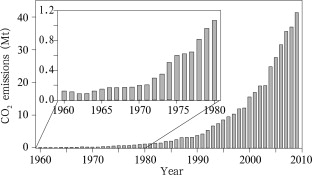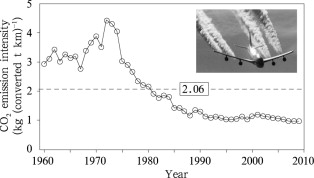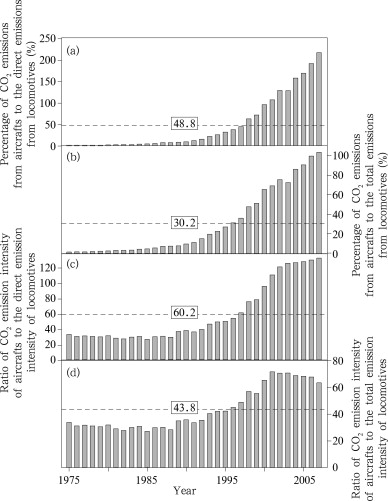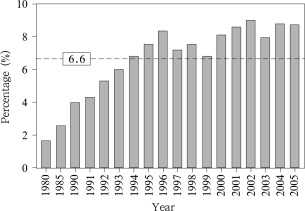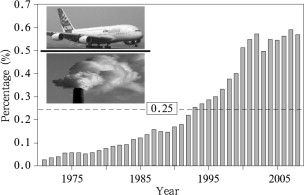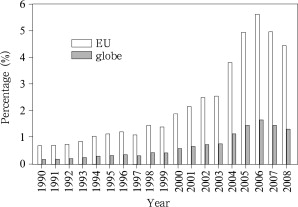Abstract
Based on data collected by Chinese Civil Aviation Statistic Center, the annual CO2 emissions of aircrafts during 1960–2009 were calculated, and the emission intensity and its dynamic characteristics were analyzed. The results show that the total CO2 emissions of aircrafts in China increased from 120×103 t in 1960 to 41.44×10s t in 2009. The CO2 emission intensity decreased from 2.9 kg (converted t km)−1 in 1960 to 0.96 kg (converted t km)−1 in 2009 at an average rate of 0.04 kg (converted t km)−1 per year. The average share of CO2 emissions of aircrafts on the total CO2 emissions from the sector of transportation, storage and post was 6.6% during 1980–2005, and 0.25% on the total emissions from fossil fuel combustion during 1971–2008.
Keywords
China civil aviation ; energy consumption of aircraft ; CO2 emissions
1. Introduction
According to the IPCC Fourth Assessment Report, increases in concentration of greenhouse gasses such as CO2 in the atmosphere are considered as one of the main factors inducing global warming, and the anthropogenic combustion of fossil fuels is considered to be the largest source of CO2 emissions [ Qin et al. , 2007 ]. The CO2 emissions from fossil fuel combustion in China were 2.8 Gt in 1994 [ CCPRCINCCC , 2004 ], 3 Gt in 2000 [ CCNARCC, 2007 ], and 4.7 Gt in 2004 [ Ding , 2009 ]. Traffic and transportation belong to a resource-utilization and energy-consuming industry, and its energy consumption continually increases year by year due to increasing passengers and freight transportation. Based on the energy consumption data in China’s traffic and transportation industry, Wu [2007] drew the conclusion that CO2 emissions from traffic and transportation industry were 166 Mt in 1994, which accounted for 5.92% of the CO2 emissions from energy using activities [ CCPRCINCCC , 2004 ]. In China, the traffic and transportation industry include highway, railway, waterway, airway and pipeline. However, only the CO2 emissions from railway during the past 30 years have been estimated [ He et al. , 2010 ], and the researches on carbon emissions of the other four transportation means have not been conducted yet.
China’s aviation industry had experienced a rapid growth over the past two decades. Its turnover increased 20% per year [ Liu , 2010 ] and the total transport turnover ranked No. 2 after the USA [ Zhou , 2010 ]. Presently, the focus of research on emissions is placed on emissions of atmospheric pollutants such as NOX during the landing and take-off cycle and cruising stage [ Xia et al ., 2008 ; Liu et al ., 2003a ; Huang et al ., 2000 ; Huang et al ., 2001 ; Liu et al ., 2003b ], and little attention was paid to the emissions of CO2 [ Zhao and Yang , 2010 ]. However, carbon emissions have become hot topics. In order to reduce the greenhouse gas emissions from aircrafts, in August 2009, the European Union (EU) introduced a legislation including civil aviation in its emissions trading scheme. This means that from 1st January 2012, the emissions trading system would cover all flights starting and/or landing in Europe, and initially, 85% of the emissions would be allocated for free and 15% would be auctioned. From 2020, all the emissions will be auctioned [ Huang et al. , 2010 ]. Before the opening of the United Nations Climate Change Conference 2009 in Copenhagen, the Chinese Government clearly put forward the target of controlling CO2 emissions. By 2020, CO2 emissions per unit of GDP should drop by 40%–45% from 2005 level. Therefore, China’s airlines face the looming emergency and pressure to reduce the greenhouse gas emissions [ Huang et al. , 2010 ]. Consequently, it is necessary to estimate CO2 emissions of China’s aviation industry considering the specific characteristics of China’s own statistical data. The estimation presented in this paper would provide valuable data on the status quo of CO2 emissions in the aviation sector of China. This research will provide useful information to respond to the emissions trading scheme and to draw up the countermeasures of energy saving and emission reduction of China’s civil aviation in the future.
2. Data and methods
2.1. Data source
In this study, data of all the indices (i.e. different fuel consumption, turnovers of freight and passengers) are extracted from the China Civil Aviation Compendium of Statistic [ DPDCAAC , 1992–2010 ]. The greenhouse gas emissions of aircrafts are from the combustion of fuel in engines. In this study, only CO2 emissions are discussed because the exhaust of modern aircrafts has little N2 O and CH4 [ IPCC , 2006 ]. In the China civil aviation transportation, aviation gasoline was widely used in the 1960s, and from the 1970s jet kerosene gradually substituted the aviation gasoline. Since the beginning of the 1980s, aviation gasoline was only used in small aircrafts, and it only accounted for less than 5% of fuel consumed in China’s aviation sector [ Huang et al. , 2010 ]. Consequently, in this study, CO2 emissions from the combustion of two types of fuel are analyzed.
2.2. Calculation of CO2 emissions
An entire flight of an aircraft includes taxiing, take-off, climbing, cruising, approaching and landing [ Liu , 2010 ]. Taxiing, take-off, climbing, approaching and landing compose a typical landing and take-off (LTO) stage. So LTO and cruising stage compose an entire flight. Most (90%) CO2 emissions occur in the cruising stage [ IPCC , 2006 ], and the CO2 emissions in the LTO stage are difficult to be estimated because many factors such as aircraft type, equipped engine type, and operation condition of engines affect the emissions. We cannot apply the methods recommended by the IPCC for the calculation of CO2 emissions of aircrafts in LTO and cruising stages [ IPCC, 2006 ] because aircraft and engine type do not match well [ Xia et al. , 2008 ]. In this research, the CO2 emissions of aircrafts at high altitude are discussed. The statistical data to calculate the indices for the estimation of greenhouse gas emissions in the aviation transport sector is insufficient. Hence, we apply the method recommended by the IPCC [2006] for the calculation of CO2 emissions. The formula is as follows:
|
|
( 1) |
Pi is the annual CO2 emissions of aircrafts in the ith year (0.01 Mt). Mi is total amount of jet kerosene consumed by aircrafts in the ith year (0.01 Mt). Qi is the total amount of aviation gasoline consumed by aircrafts in the ith year (0.01 Mt). Nm and Nq are the net calorific values of jet kerosene and aviation gasoline, respectively (kJ g−1 ). Fm and Fq are the emission factors of jet kerosene and aviation gasoline, respectively (ng J−1 ). Nm , Nq , Fm and Fq are the default values according to the IPCC, 44.1 kJ g−1 , 44.3 kJ g−1 , 71,500 ng g−1 and 70,000 ng g−1 , respectively.
2.3. Calculation of CO2 emission intensities
In the civil aviation transport sector, the total transport turnover includes passenger turnover (person km) and freight turnover (t km). But the aircrafts energy consumptions for the foresaid two kinds of turnover are not separately estimated. The unit of converted t km is usually used in the calculation of total turnover of civil transport. In China, 75 kg per passenger was used for converting the passenger turnover before 2001. Since 2001, 90 kg per passenger has been used [ DPDCAAC , 1992–2010 ]. In this paper, we also used 90 kg per passenger when converting the passenger turnover. CO2 emission intensity of aircrafts refers to the amount of CO2 per unit of transport turnover (converted t km).
3. CO2 emissions of aircrafts in China
3.1. CO2 emission amount and intensities
Before 1980 the CO2 emissions from aircrafts in China were low, with annual average only 328×103 t during 1960–1979. Since the beginning of 1980s, especially after 1990s, the CO2 emissions increased rapidly (Fig. 1 ). For example, the annual amount of CO2 emissions was above 2 Mt, 5 Mt, 10 Mt, 20 Mt, and 40 Mt in 1985, 1992, 1997, 2004 and 2009, respectively. The annual average amount of CO2 emissions was 12.31 Mt during 1980–2009. For the comparisons among different decades, annual average amount of CO2 emissions was 136×103 t with the increasing rate of 6×103 t per year, 520×103 t with the increasing rate of 85×103 t per year, 2.08 Mt with the increasing rate of 235×103 t per year, 7.99 Mt with the increasing rate of 941×103 t per year, and 26.87 Mt with the increasing rate of 2.87 Mt per year during the 1960s, 1970s, 1980s, 1990s, and 2000s, respectively (Table 1 ). The average increasing rate of CO2 emissions for aircrafts in China was 826 x103 t per year.
|
|
|
Figure 1. Annual CO2 emissions from aircrafts of China’s civil aviation during 1960–2009 |
| Decade | Increasing rate (103 t per year) | Average increasing rate (%) |
|---|---|---|
| 1960s | 6 | 4 |
| 1970s | 85 | 19 |
| 1980s | 235 | 13 |
| 1990s | 941 | 14 |
| 2000s | 2,870 | 11 |
Three phases in the CO2 emission intensity of aircrafts in China can be distinguished (Fig. 2 ). In the first phase (1960–1972), a fluctuating increase from 2.9 kg (converted t km)−1 to 4.4 kg (converted t km)−1 at a rate of 0.12 kg (converted t km)−1 per year is apparent. The second phase (1973–1985), shows a strong decrease from 4.3 kg (converted t km)−1 to 1.4 kg (converted t km)−1 at a rate of 0.24 kg (converted t km)−1 per year. In the third phase (1986–2009), a slight decrease from 1.42 kg (converted t km)−1 to 0.96 kg (converted t km)−1 at a rate of 0.02 kg (converted t km)−1 per year is observed. As for the comparison among the different decades, annual average CO2 emission intensity is 3.18 kg (converted t km)−1 with the increasing rate of 0.08 kg (converted t km)−1 per year, 3.33 kg (converted t km)−1 with the decreasing rate of 0.19 kg (converted t km)−1 per year, 1.61 kg (converted t km)−1 with the decreasing rate of 0.09 kg (converted t km)−1 per year, 1.09 kg (converted t km)−1 with the decreasing rate of 0.03 kg (converted t km)−1 per year, and 1.06 kg (converted t km)−1 with the decreasing rate of 0.02 kg (converted t km)−1 per year during 1960s, 1970s, 1980s, 1990s, and 2000s, respectively (Table 2 ). The CO2 emission intensity decreased at a rate of 0.04 kg (converted t km)−1 per year during 1960–2009. The causes include the replacement of old aircrafts, expansion of the fleet, optimization of airline networks, improvement in operation and organization, and progress in the technologies of aero-engines, etc.
|
|
|
Figure 2. Annual CO2 emission intensity from aircrafts of China’s civil aviation during 1960–2009 |
| Decade | Increasing rate (kg (converted t km)−1 per year) | Average increasing rate (%) |
|---|---|---|
| 1960s | 0.08 | 3 |
| 1970s | −0.19 | −6 |
| 1980s | −0.09 | −5 |
| 1990s | −0.03 | −3 |
| 2000s | −0.02 | −2 |
3.2. Comparison with other transport industries
Compared with the direct emissions of locomotives [ He et al. , 2010 ], the annual amount of CO2 emissions from aircrafts is low before 1990, and the annual average percentage of aircrafts to locomotives is only 4.1% (Fig. 3 a). However, since 1990s CO2 emissions of aircrafts have increased rapidly, while the direct CO2 emissions of locomotives have decreased. The former exceeded the latter in 2001, and the former was 2.18 times of the latter in 2007. The annual average percentage of CO2 emissions from aircrafts to the direct emissions from locomotives is 48.8% during 1975–2007. Compared with the total emissions of locomotives (Fig. 3 b), the annual percentage of aircrafts to locomotives was lower than 10% before 1991. However, the CO2 emissions of aircrafts accounted for 50% of the total CO2 emissions of locomotives in 1999, nearly 100% in 2006, and exceeded the latter in 2007. The annual average percentage of CO2 emissions from aircrafts to the total emissions from locomotives is 30.2% during 1975–2007. Here, we calculate the total turnover of locomotives using the method of aircrafts first, and then analyze the direct and total CO2 emission intensities. Comparing the CO2 emission intensity of aircrafts with that of locomotives (Fig. 3 c and 3 d), we find that the CO2 emission intensity of aircrafts is far higher than the direct and total CO2 emission intensity of locomotives. The ratios of CO2 emission intensity to the direct and total CO2 emission intensity of locomotives increased from 34.3 and 34.1 in 1975 to 133.2 and 63.4 in 2007, and the average ratios were 60.2 and 43.8, respectively.
|
|
|
Figure 3. Annual ratio of aircraft CO2 emissions over (a) direct and (b) total CO2 emissions from locomotives, and aircraft CO2 emission intensity over (c) direct and (d) total CO2 emission intensity from locomotives |
Based on the environmental Kuznets curves (EKC) model, Hu et al. [2008] developed a factor decomposition model of CO2 emissions in China. In their study, the CO2 emissions in the sector of transportation, storage and post industries in China were 65.68 Mt in 1980 and increased to 315.51 Mt in 2005. Our study shows that the share of the CO2 emissions of aircrafts on the total emissions in the sector of transportation, storage and post industries in China is low, and the average value is only 6.6%. However, the percentage increased from 1.6% in 1980 to 8.8% in 2005 (Fig. 4 ). Before the middle 1990s, the percentage showed an increasing trend, and stagnated around 8% from 1997 to 2005.
|
|
|
Figure 4. Annual share of the CO2 emissions of aircrafts on the total CO2 emissions from the sector of transportation, storage and post industries in China |
According to the estimations by the International Energy Agency [ IEA , 2011 ] and the results in this paper, the mean share of the CO2 emissions of aircrafts on the total CO2 emissions from the combustion of fossil fuel in China is low (0.25%) during 1971–2008, but increased from 0.03% in 1971 to 0.57% in 2008 (Fig. 5 ).
|
|
|
Figure 5. Yearly percentage of the CO2 emissions of aircrafts to the total CO2 emissions from fossil fuel combustion in China |
4. Discussion and Conclusions
4.1. Discussion
CO2 emissions of aircrafts in China result from international aviation bunkers and domestic aviation bankers. In the civil aviation transport sector, the energy consumption of aircrafts is not estimated separately. The question is how to separately estimate the CO2 emissions from the two types of bunkers. Especially how to explore the CO2 emission amount and its percentage to the total emissions needs further studies in future. Presently, the construction of high-speed railways is increasing, and some high-speed railways such as the Beijing-Tianjin intercity railway, the Wuhan-Guangzhou high-speed railway and the Zhengzhou-Xi’an high-speed railway have been put into operation. In terms of passenger transportation, high-speed railways can substitute aircrafts. At present, the CO2 emission intensity of aircrafts cannot be compared with that of high-speed railways because the energy consumption data of high-speed railways have not been published yet. So if possible, comparing the CO2 emission intensity of aircrafts for passenger transportation with that of high-speed railways also requires further analysis in the future.
Once the emissions trading scheme of the EU comes into force, China’s airlines will face a bill of even hundreds of millions of RMB for the purchase of emission credits, and the number would reach 3 billion RMB in 2020. If only one flight from China to the EU each day is added, 15 million RMB cost will be added to the airlines each year [ CCAN , 2011 ]. This will do harm to the operation and exploration of the airlines between China and the EU, and hinder the development of China’s civil aviation industry. According to the CO2 emissions of the world’s international flights estimated by the International Energy Agency [ IEA, 2011 ], the CO2 emissions of China’s international flights are far less than those of the EU (27 European countries), and the annual average is only 2.63 Mt during 1990–2008, while that of the EU and the globe is 100 Mt and 340 Mt, respectively. With the rapid development of China’s civil aviation industry, although the CO2 emissions of China’s international flights are increasing (Fig. 6 ), the ratio of China’s emissions to the EU or the globe is still very low, with the highest only 6% and 2%, respectively. The average percentage during 1990–2008 is 2.3% and 0.69% to the EU and the globe, respectively (Fig. 6 ).
|
|
|
Figure 6. Yearly percentage of the CO2 emissions from China’s international aviation bunkers to those from the EU and the globe |
In fact, the civil aviation industries in Europe and North America have developed for a long time, and have completed international airline networks. So their CO2 emissions are high, and the growth rate will be low in future. However, the civil aviation industries in many developing countries such as China are in developing now, and the international flights and airline networks are incomplete, so their CO2 emissions are low but the growth rate will be high in future. The reality of developing countries was not considered when the EU drew up the emissions trading scheme, and the inclusion of aviation in the emissions trading scheme also violated the climate change principle of common but differentiated responsibilities in the United Nations Framework Convention on Climate Change and the Kyoto Protocol. China Civil Aviation Transport Association has expressed strong opposition to the inclusion of aviation in the emissions trading scheme, and will take appropriate corresponding measures to protect Chinese airlines interest and development in the global air transport industry [ CCR , 2011 ].
In order to reduce the CO2 emissions and intensity of crafts in China, the airline companies in China must decrease fuel consumption and increase the efficiency. The measures include: 1) Fuel saving and emission reduction in flight, such as optimizing flight level, replenishing fuel based on actual payload, shortening flight distance, and maintaining economic flight speed, etc. 2) Fuel saving and emission reduction in the preparation process, such as using ground power supply, maintaining the smoothness of fuselage, etc. 3) Fuel saving and emission reduction in replacing the old aircrafts, for example, selecting the Boeing 787 Dreamliner, Airbus A350. 4) Fuel saving and emission reduction in using new aero-engines with low energy consumption, low noise and high thrust-weight ratio, such as Trent 1000, Trent XWB and GEnx aeroengines, etc.
4.2. Conclusions
Annual CO2 emissions of aircrafts in China increased from 120×103 t in 1960 to 41.44×106 t in 2009 at an average rate of 826×103 t per year. The emission intensity decreased from 2.9 kg (converted t km)−1 in 1960 to 0.96 kg (converted t km)−1 in 2009 at an average rate of 0.04 kg (converted t km)−1 per year.
Compared with the direct emissions of locomotives, the annual CO2 emissions from aircrafts exceeded the direct CO2 emissions of locomotives in 2001. The CO2 emission intensity of aircrafts is far larger than the direct and total CO2 emission intensities of locomotives, and the average ratio is 60.2 and 43.8, respectively.
The share of the CO2 emissions of aircrafts on the total emissions in the sector of transportation, storage and post industries in China is low with the average value of 6.6%, and the percentage increased from 1.6% in 1980 to 8.8% in 2005. The percentage of the CO2 emissions of aircrafts to the total CO2 emissions from the combustion of fossil fuel in China is low, with the average value of 0.25% during 1971–2008, and the percentage increased gradually year by year.
Acknowledgements
The study was supported by Climate Change Special Project of China Meteorological Administration (No. CCSF2011-14).
References
- CCAN, 2011 CCAN (China’s Civil Aviation News), 2011[2011-06-07]: It should be impartial to the developing countries when limit carbon emissions. Accessed http://www.caacnews.com.cn/2010np/20100607/144191.html .
- CCNARCC (Compilation Committee of National Assessment Report of Climate Change), 2007 CCNARCC (Compilation Committee of National Assessment Report of Climate Change); China’s National Assessment Report on Climate Change (in Chinese), Science Press (2007), p. 422
- CCPRCINCCC (Compilation Commission of the People’s Republic of China Initial National Communication on Climate Change), 2004 CCPRCINCCC (Compilation Commission of the People’s Republic of China Initial National Communication on Climate Change); The People’s Republic of China Initial National Communication on Climate Change (in Chinese), China Planning Press (2004), p. 78
- CCR, 2011 CCR (Climate Connect Research), 2011[2011-01-11]: Chinese airlines send formal notice against EU ETS (Aviation). Accessed http://www.climate-connect.co.uk/Home/?q=node/447 .
- Ding, 2009 Y.-H. Ding; Climate Change Research over China: Science, Impact, Abatement and Strategy Study (in Chinese), China Environmental Science Press (2009), p. 455
- DPDCAAC (Development and Planning Department of Civil Aviation Administration of China), 1992–2010 DPDCAAC (Development and Planning Department of Civil Aviation Administration of China); Statistical Data on Civil Aviation of China (1992–2010) (in Chinese), China Civil Aviation Publishing House (1992–2010), p. 6000
- He and Li, 2010 J.-C. He, Y.-Z. Li; Estimation of CO2 emissions of locomotives in China (1975–2005) ; Adv. Clim. Change Res., 1 (1) (2010), pp. 40–45
- Hu et al., 2008 C.-Z. Hu, X.-J. Huang, T. Zhong, et al.; Character of carbon emission in China and its dynamic development analysis; China Population Resources and Environment (in Chinese), 18 (3) (2008), pp. 38–42
- Huang et al., 2010 Q. Huang, Q. Qi, X.-H. Zhang; The pressure and countermeasures of China’s civil aviation for carbon emission reduction; Transportation Construction & Management (in Chinese), 4 (2010), pp. 20–25
- Huang et al., 2000 Y. Huang, G.-L. Zhou, S.-S. Wu; A preliminary investigation on the inventory of NOx emitted from CAAC flights over China; Acta Scientiae Circumstantiae (in Chinese), 20 (2) (2000), pp. 179–182
- Huang et al., 2001 Y. Huang, D. Wu, J. Wang, et al.; Further assessment of the NOX emission from CAAC fleet over China ; Journal of Beijing University of Aeronautics and Astronautics (in Chinese), 27 (3) (2001), pp. 289–292
- IEA, 2011 IEA (International Energy Agency), 2011 [2011-01-10]: CO2 emissions from fuel combustion 2010-highlights. Accessed http://www.iea.org/publications/free_new_Desc.asp?PUBS_ID=2143 .
- IPCC, 2006 IPCC; H.S. Eggleston (Ed.), et al. , 2006 IPCC guidelines for national greenhouse gas inventories. National Greenhouse Gas Inventories Programme, IGES, Japan (2006), pp. 50–80
- Liu, 2010 D. Liu; An Introduction to Civil Aviation (in Chinese), China Civil Aviation Publishing House (2010), p. 245
- Liu et al., 2003a G.-E. Liu, H.-F. Wang, P. Lü, et al.; Gas turbine engine emissions measurement; Journal of Aerospace Power (in Chinese), 18 (3) (2003), pp. 348–352
- Liu et al., 2003b Y. Liu, I. Isaksen, J. Sundet, et al.; Impact of aircraft NOX emission on NOX and ozone over China ; Advances in Atmospheric Sciences, 20 (4) (2003), pp. 565–574
- Qin et al., 2007 D.-H. Qin, Z.-L. Chen, Y. Luo, et al.; Updated understanding of climate change sciences; Advances in Climate Change Research (in Chinese), 3 (2) (2007), pp. 63–73
- Wu, 2007 W.-H. Wu; The situation of energy consumption and emission of transportation sectors in China and comparison with typical countries; Energy of China (in Chinese), 29 (10) (2007), pp. 19–22
- Xia et al., 2008 Q. Xia, H.-F. Zuo, J.-L. Yang; Evaluation of LTO cycle emissions from aircraft in China’s civil aviation airports; Acta Scientiae Circumstantiae (in Chinese), 28 (7) (2008), pp. 1469–1474
- Zhao and Yang, 2010 W.-Z. Zhao, W.-W. Yang; Study on algorithm of CO2 compensation for flight passenger ; Journal of Civil Aviation University of China (in Chinese), 28 (1) (2010), pp. 38–40
- Zhou, 2010 L.-P. Zhou; The development of China’s civil aviation industry: The problems and the countermeasures; China Civil Aviation (in Chinese), 4 (2010), pp. 28–30
Document information
Published on 15/05/17
Submitted on 15/05/17
Licence: Other
Share this document
claim authorship
Are you one of the authors of this document?
